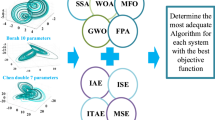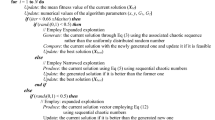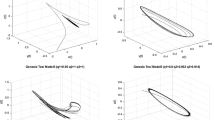Abstract
The random structures in the Aquila optimization algorithm are modeled with fractional chaotic oscillators, and the fractional-order chaotic oscillator-based Aquila optimization (FOCOBAO) algorithm was suggested in this study. First of all, the basic AO algorithm was examined. In particular, random variables that affect the optimization performance of the AO algorithm have been determined. Then, instead of the determined random variables, the coefficients were derived with fractional chaotic oscillators and used in the FOCOBAO. The superiority of the proposed algorithm was primarily demonstrated via twenty-three benchmark functions. The results were matched with GO, EO, GWO, MPA, WOA, SMA and basic AO optimization algorithms. Then, the design of the Lorenz chaotic oscillator, according to maximum chaotic objective function, is a topic that remains up to date in the literature. In this study, a fractional chaotic Lorenz oscillator was designed with FOCOBAO as an engineering application. Especially for maximum chaoticity, maximum positive Lyapunov exponents were determined. In this way, a different design process has been proposed in the literature. The basic AO algorithm, which includes stochastic processes, was developed with fractional chaotic oscillators, and a deterministic method was obtained. The parameters of the Lorenz system were calculated for maximum chaoticity, and the results were presented comparatively.




Similar content being viewed by others
Data availability
Data will be made available on reasonable request.
Change history
08 November 2023
A Correction to this paper has been published: https://doi.org/10.1007/s00521-023-09077-9
References
Coello CAC (2022) Constraint-handling techniques used with evolutionary algorithms. In: GECCO 2022 Companion—Proc 2022 Genet Evol Comput Conf pp 1310–1333. https://doi.org/10.1145/3520304.3533640
Folino G, Forestiero A, Spezzano G (2006) A jxta based asynchronous peer-to-peer implementation of genetic programming. J Softw 1:12–23. https://doi.org/10.4304/jsw.1.2.12-23
Forestiero A (2017) Bio-inspired algorithm for outliers detection. Multimed Tools Appl 76:25659–25677. https://doi.org/10.1007/s11042-017-4443-1
Abualigah L, Elaziz MA, Khasawneh AM et al (2022) Meta-heuristic optimization algorithms for solving real-world mechanical engineering design problems: a comprehensive survey, applications, comparative analysis, and results. Neural Comput Appl 346(34):4081–4110. https://doi.org/10.1007/S00521-021-06747-4
Storn R, Price K (1997) Differential evolution: a simple and efficient heuristic for global optimization over continuous spaces. J Glob Optim 11:341–359
Yao X, Liu Y, Lin G (1999) Evolutionary programming made faster. IEEE Trans Evol Comput doi 10(1109/4235):771163
Grefenstette JJ Genetic algorithms and machine learning
Gandomi AH (2014) Interior search algorithm (ISA): a novel approach for global optimization. ISA Trans 53:1168–1183. https://doi.org/10.1016/J.ISATRA.2014.03.018
Koza JR (1994) Genetic programming as a means for programming computers by natural selection. Stat Comput 4:87–112. https://doi.org/10.1007/BF00175355/METRICS
Abualigah L, Diabat A, Mirjalili S et al (2021) The arithmetic optimization algorithm. Comput Methods Appl Mech Eng 376:113609. https://doi.org/10.1016/J.CMA.2020.113609
Moghdani R, Salimifard K (2018) Volleyball premier league algorithm. Appl Soft Comput J 64:161–185. https://doi.org/10.1016/j.asoc.2017.11.043
Dai C, Zhu Y, Chen W (2007) Seeker optimization algorithm. pp 167–176
Rao RV, Savsani VJ, Vakharia DP (2011) Teaching–learning-based optimization: a novel method for constrained mechanical design optimization problems. Comput Des 43:303–315. https://doi.org/10.1016/J.CAD.2010.12.015
Mousavirad SJ, Ebrahimpour-Komleh H (2017) Human mental search: a new population-based metaheuristic optimization algorithm. Appl Intell 47:850–887. https://doi.org/10.1007/S10489-017-0903-6/TABLES/17
Samuel P, Subbaiyan S, Balusamy B et al (2021) A technical survey on intelligent optimization grouping algorithms for finite state automata in deep packet inspection. Arch Comput Methods Eng 28:1371–1396. https://doi.org/10.1007/S11831-020-09419-Z/FIGURES/5
Mirjalili S, Mirjalili SM, Lewis A (2014) Grey wolf optimizer. Adv Eng Softw 69:46–61. https://doi.org/10.1016/j.advengsoft.2013.12.007
Alatas B (2011) ACROA: artificial chemical reaction optimization algorithm for global optimization. Expert Syst Appl 38:13170–13180. https://doi.org/10.1016/J.ESWA.2011.04.126
Zhao W, Wang L, Zhang Z (2019) Atom search optimization and its application to solve a hydrogeologic parameter estimation problem. Knowledge-Based Syst 163:283–304. https://doi.org/10.1016/J.KNOSYS.2018.08.030
Nematollahi AF, Rahiminejad A, Vahidi B (2017) A novel physical based meta-heuristic optimization method known as lightning attachment procedure optimization. Appl Soft Comput 59:596–621. https://doi.org/10.1016/J.ASOC.2017.06.033
Faramarzi A, Heidarinejad M, Stephens B, Mirjalili S (2020) Equilibrium optimizer: a novel optimization algorithm. Knowledge-Based Syst. https://doi.org/10.1016/j.knosys.2019.105190
Xie L, Zeng J, Cui Z (2009) General framework of artificial physics optimization algorithm. In: Proceedings 2009 World congress on nature and biologically inspired computing, NABIC
Sharma M, Kaur P (2021) A comprehensive analysis of nature-inspired meta-heuristic techniques for feature selection problem. Arch Comput Methods Eng 28:1103–1127. https://doi.org/10.1007/S11831-020-09412-6/TABLES/17
Mirjalili S, Gandomi AH, Mirjalili SZ et al (2017) Salp swarm algorithm: a bio-inspired optimizer for engineering design problems. Adv Eng Softw. https://doi.org/10.1016/j.advengsoft.2017.07.002
Gandomi AH, Alavi AH (2012) Krill herd: a new bio-inspired optimization algorithm. Commun Nonlinear Sci Numer Simul 17:4831–4845. https://doi.org/10.1016/J.CNSNS.2012.05.010
Jain M, Singh V, Rani A (2019) A novel nature-inspired algorithm for optimization: squirrel search algorithm. Swarm Evol Comput. https://doi.org/10.1016/j.swevo.2018.02.013
Mirjalili S, SMAL, (2014) Grey wolf optimizer. Adv Eng Softw 69:46–61
Eberhart R, Kennedy J (1995) New optimizer using particle swarm theory. In: Proceedings of the sixth international symposium on micro machine and human science pp 39–43. https://doi.org/10.1109/MHS.1995.494215
Kashani AR, Chiong R, Mirjalili S, Gandomi AH (2021) Particle swarm optimization variants for solving geotechnical problems: review and comparative analysis. Arch Comput Methods Eng 28:1871–1927. https://doi.org/10.1007/S11831-020-09442-0/TABLES/16
Eskandar H, Sadollah A, Bahreininejad A, Hamdi M (2012) Water cycle algorithm—a novel metaheuristic optimization method for solving constrained engineering optimization problems. Comput Struct 110–111:151–166. https://doi.org/10.1016/J.COMPSTRUC.2012.07.010
Bayraktar Z, Komurcu M, Werner DH (2010) Wind driven optimization (WDO): a novel nature-inspired optimization algorithm and its application to electromagnetics. In: 2010 IEEE Int Symp Antennas Propag CNC-USNC/URSI Radio Sci Meet - Lead Wave, AP-S/URSI 2010. https://doi.org/10.1109/APS.2010.5562213
Kirkpatrick S, Gelatt CD, Vecchi MP (1983) Optimization by simulated annealing. Science 220:671–680. https://doi.org/10.1126/SCIENCE.220.4598.671
Ewees AA, Abualigah L, Yousri D et al (2022) Improved slime mould algorithm based on firefly algorithm for feature selection: a case study on QSAR model. Eng Comput 38:2407–2421. https://doi.org/10.1007/S00366-021-01342-6/TABLES/13
Şahin CB, Dinler ÖB, Abualigah L (2021) Prediction of software vulnerability based deep symbiotic genetic algorithms: phenotyping of dominant-features. Appl Intell 51:8271–8287. https://doi.org/10.1007/S10489-021-02324-3/FIGURES/7
Forestiero A (2016) Self-organizing anomaly detection in data streams. Inf Sci 373:321–336
Wang WC, Xu L, Chau KW, Zhao Y, Xu DM et al (2022) An orthogonal opposition-based-learning Yin–Yang-pair optimization algorithm for engineering optimization. Eng Comput 38:1149–1183. https://doi.org/10.1007/S00366-020-01248-9/FIGURES/10
Kundu T, Garg H (2022) A hybrid ITLHHO algorithm for numerical and engineering optimization problems. Int J Intell Syst 37:3900–3980. https://doi.org/10.1002/INT.22707
Ferreira MP, Rocha ML, Silva Neto AJ, Sacco WF (2018) A constrained ITGO heuristic applied to engineering optimization. Expert Syst Appl 110:106–124. https://doi.org/10.1016/J.ESWA.2018.05.027
Rao H, Jia H, Wu D et al (2022) A modified group teaching optimization algorithm for solving constrained engineering optimization problems. Math 10:3765. https://doi.org/10.3390/MATH10203765
Han X, Xu Q, Yue L et al (2020) An improved crow search algorithm based on spiral search mechanism for solving numerical and engineering optimization problems. IEEE Access 8:92363–92382. https://doi.org/10.1109/ACCESS.2020.2980300
Truby RL, Della SC, Rus D (2020) Distributed proprioception of 3d configuration in soft, sensorized robots via deep learning. IEEE Robot Autom Lett 5:3299–3306. https://doi.org/10.1109/LRA.2020.2976320
Huang Q, Huang R, Hao W et al (2020) Adaptive power system emergency control using deep reinforcement learning. IEEE Trans Smart Grid 11:1171–1182. https://doi.org/10.1109/TSG.2019.2933191
Stokes JM, Yang K, Swanson K et al (2020) A deep learning approach to antibiotic discovery. Cell 180:688-702e13. https://doi.org/10.1016/j.cell.2020.01.021
Banan A, Nasiri A, Taheri-Garavand A (2020) Deep learning-based appearance features extraction for automated carp species identification. Aquac Eng 89:102053. https://doi.org/10.1016/j.aquaeng.2020.102053
Ning C, You F (2019) Optimization under uncertainty in the era of big data and deep learning: when machine learning meets mathematical programming. Comput Chem Eng 125:434–448. https://doi.org/10.1016/j.compchemeng.2019.03.034
Petráš I (2011) Fractional-Order Nonlinear Systems
Ates A (2021) Enhanced equilibrium optimization method with fractional order chaotic and application engineering. Neural Comput Appl 33(16):9849–9876. https://doi.org/10.1007/s00521-021-05756-7
Zainel QM, Darwish SM, Khorsheed MB (2022) Employing quantum fruit fly optimization algorithm for solving three-dimensional chaotic equations. Math 10:4147. https://doi.org/10.3390/MATH10214147
Valencia-Ponce MA, Tlelo-Cuautle E, De La Fraga LG (2021) Estimating the highest time-step in numerical methods to enhance the optimization of chaotic oscillators. Math 9:1938. https://doi.org/10.3390/MATH9161938
Ates A, Chen YQ (2021) Fractional order chaotic model based enhanced equilibrium optimization algorithm for controller design of 3 DOF hover flight system. Proc ASME Des Eng Tech Conf 7:69307. https://doi.org/10.1115/DETC2021-69307
Abualigah L, Yousri D, Abd Elaziz M et al (2021) Aquila optimizer: a novel meta-heuristic optimization algorithm. Comput Ind Eng 157:107250. https://doi.org/10.1016/J.CIE.2021.107250
Abualigah L, Houssein EH, Abd Elaziz M, Oliva D, (2022) Integrating meta-heuristics and machine learning for real-world optimization problems. In: Aquila optimizer based PSO swarm intelligence for IoT task scheduling application in cloud computing. pp 481–497
Gul F, Mir A, Mir I, Mir S (2022) A centralized strategy for multi-agent exploration. IEEE Access 10:126871–126884
Danca MF (2021) Matlab code for lyapunov exponents of fractional-order systems Part II: The Noncommensurate Case. Int J Bifurc Chaos 31:2150187. https://doi.org/10.1142/S021812742150187X
Author information
Authors and Affiliations
Corresponding author
Ethics declarations
Conflict of interest
Authors declare that we have no conflict of interest.
Additional information
Publisher's Note
Springer Nature remains neutral with regard to jurisdictional claims in published maps and institutional affiliations.
The original online version of this article was revised: The affiliation 11 has been added to author Laith Abualigah.
Rights and permissions
Springer Nature or its licensor (e.g. a society or other partner) holds exclusive rights to this article under a publishing agreement with the author(s) or other rightsholder(s); author self-archiving of the accepted manuscript version of this article is solely governed by the terms of such publishing agreement and applicable law.
About this article
Cite this article
Cavlak, Y., Ateş, A., Abualigah, L. et al. Fractional-order chaotic oscillator-based Aquila optimization algorithm for maximization of the chaotic with Lorentz oscillator. Neural Comput & Applic 35, 21645–21662 (2023). https://doi.org/10.1007/s00521-023-08945-8
Received:
Accepted:
Published:
Issue Date:
DOI: https://doi.org/10.1007/s00521-023-08945-8




